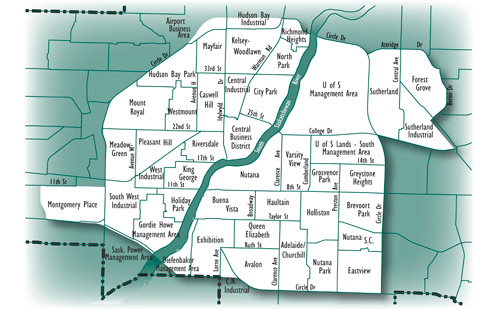Vacant Lot & Adaptive Reuse Strategy
Vacant Lot & Adaptive Reuse Incentive Program
Program Updates
City Council approved changes to the Vacant Lot and Adaptive Reuse Incentive Program at the December 2023 Regular Council Meeting which provide efficiencies to program administration and focus on continuing to incentivize larger projects.
The Vacant Lot & Adaptive Reuse Incentive Program is designed to encourage development on existing vacant or brownfield sites, and the reuse of vacant buildings in established areas of the city, including the City Centre, by providing financial and/or tax based incentives to owners of eligible properties.
Under the Vacant Lot & Adaptive Reuse Incentive Program, a Maximum Incentive Amount will be determined, equivalent to the increment between the existing property taxes (city portion) and the taxes paid upon completion, multiplied by five years.
The amount of the final incentive, or Earned Incentive Amount is determined through an evaluation system, based on points linked to policy objectives identified in the City's Official Community Plan. The points are used to determine what percentage of the total Maximum Incentive Amount may be available to the applicant. Under the Program, applicants are given a choice of a five-year incremental tax abatement, or a cash grant determined by the Earned Incentive Amount.
The evaluation system is based on points out of 100. For instance, a score of 60 points earns 60% payout (upon completion) of the Maximum Incentive Amount. See the Maximum Incentive Grant Amount Example below:
| Grant/Tax Abatement Calculation | |
|---|---|
| Tax Increment (City portion) | $10,000 x 5 years |
| Maximum Incentive Amount x Points (based on project evaluation) |
$50,000 x 60/100 |
| Incentive Amount | $30,000 (paid on project completion) |
To qualify under the incentive program, applicants will need to submit an application and a full development proposal prior to the beginning of construction (include as many details on the project as possible) for an existing vacant or brownfield site, or an adaptive reuse project that is within the area shown on the map below. Each application will be reviewed to ensure eligibility under the program. Applications for Tax Abatements are subject to the approval of City Council, and cash grants are subject to the approval of the General Manager, Community Services. A minimum vacancy period of 48 months is among the requirements to qualify for an incentive, except for sites within the City Centre boundary, which do not have a minimum vacancy requirement. All residential projects are required to include a minimum of 3 dwelling units.

Vacant Lot Garden Incentive
The Vacant Lot Garden incentive has been designed to promote gardening as an interim use on vacant lots, promote urban agriculture as well as address the aesthetic and safety issues of vacant lots. The establishment of a garden on a vacant lot will not affect the opportunity for future incentives under the VLAR Program when the lot becomes developed.
To earn the incentive, applicants must convert a minimum of 50% or 100 m2 of a vacant lot, whichever is smaller, into a garden and maintain the site in a safe and orderly manner. All noxious weeds must be controlled, and the garden must not generate odour, dust, drainage impacts, or noise that may impact neighbouring properties or the right of way.
The incentive is an annual grant for the property owner equal to 50% of municipal land tax, for up to five years. A written agreement is required between the property owner and gardener(s) if they are not one and the same, to indicate that there is an arrangement in place to permit a garden to operate on the vacant lot. There is no minimum vacancy requirement to qualify for the Vacant Lot Garden incentive.
Vacant Lot Inventory
As part of the Vacant Lot & Adaptive Reuse Strategy, the City of Saskatoon maintains a comprehensive inventory of undeveloped land, which also includes surface parking lots. All lands that fall into these "undeveloped" categories are considered vacant.
The inventory includes the following information about vacant sites:
- Civic Address
- Site Area
- Neighbourhood
- Zoning Designation
- Legal Land Description
The inventory only includes properties within the VLAR Program boundary, and excludes any sites that are considered to be undevelopable (e.g. walkways, right-of-ways, and other residual parcels). The inventory excludes ownership information of non-City-owned sites to ensure compliance with federal and provincial privacy legislation. Land title details can be accessed through the Information Service Centre at www.isc.ca.
Please note that the Vacant Lot Inventory comes with the following disclaimer:
The City of Saskatoon provides the following records for reference only, as an accompanying document to the Vacant Lot and Adaptive Reuse (VLAR) Incentive Program. IT IS NOT INTENDED AS A LIST OF PROPERTIES FOR SALE or as a development opportunity. This list includes only sites located within the VLAR Program boundary. Using available records, the sites are assumed to have no permanent structures. Sites on this list may or may not be available or suitable for redevelopment purposes. While efforts have been made to identify vacant properties that could qualify for a VLAR incentive, the Neighbourhood Planning Section must review VLAR Program applications to confirm eligibility. City of Saskatoon staff are not able to provide ownership information of non-City-owned lots.
Contact the Neighbourhood Planning Section at 306-975-2645 to discuss potential eligibility of a specific site to qualify for a VLAR incentive. Contact Saskatoon Land at 306-975-3278 to discuss purchasing City-owned lots.
Brownfield Redevelopment
The redevelopment of brownfield sites result in numerous benefits to municipalities, citizens, and the developers who take on these projects. Increased tax revenue, improved environmental condition, economic opportunities, job creation, and revitalized neighbourhoods are just some of the benefits that are realized by brownfield development. However, brownfield redevelopment has its challenges including difficulty finding financing, liability concerns, regulatory requirements, and the perception and stigma association with potential contamination.
Projects that involve the redevelopment of Brownfield sites may be eligible for incentives under the Vacant Lot and Adaptive Reuse Incentive Program.

